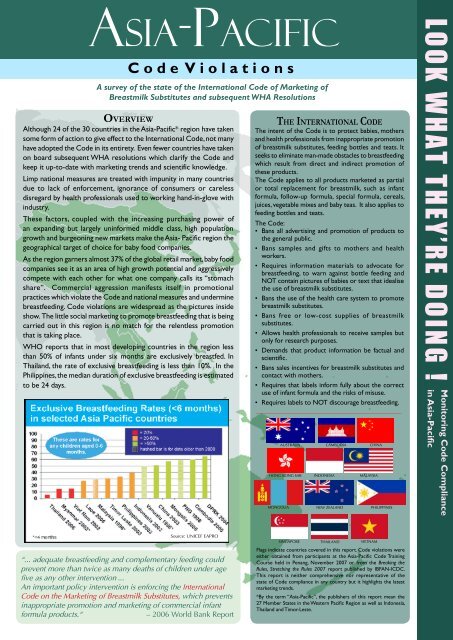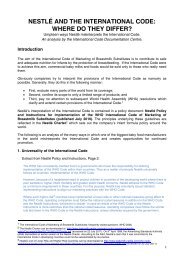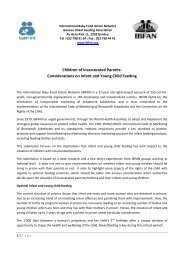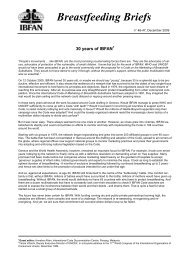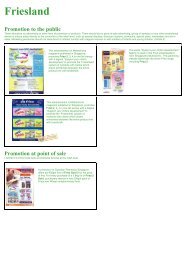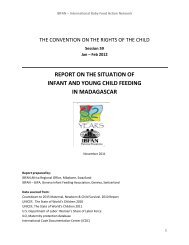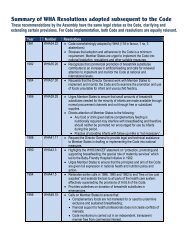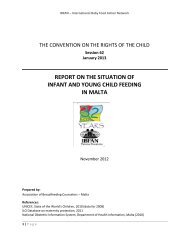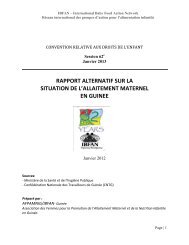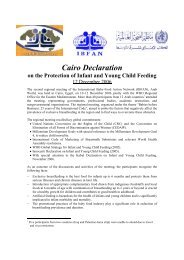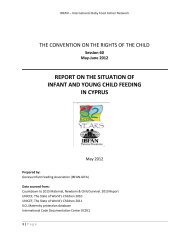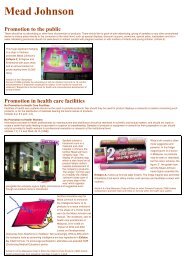AsiA-PAcific - IBFAN
AsiA-PAcific - IBFAN
AsiA-PAcific - IBFAN
Create successful ePaper yourself
Turn your PDF publications into a flip-book with our unique Google optimized e-Paper software.
Asia-Pacific<br />
C o d e V i o l a t i o n s<br />
A survey of the state of the International Code of Marketing of<br />
Breastmilk Substitutes and subsequent WHA Resolutions<br />
Overview<br />
Although 24 of the 30 countries in the Asia-Pacific* region have taken<br />
some form of action to give effect to the International Code, not many<br />
have adopted the Code in its entirety. Even fewer countries have taken<br />
on board subsequent WHA resolutions which clarify the Code and<br />
keep it up-to-date with marketing trends and scientific knowledge.<br />
Limp national measures are treated with impunity in many countries<br />
due to lack of enforcement, ignorance of consumers or careless<br />
disregard by health professionals used to working hand-in-glove with<br />
industry.<br />
These factors, coupled with the increasing purchasing power of<br />
an expanding but largely uninformed middle class, high population<br />
growth and burgeoning new markets make the Asia- Pacific region the<br />
geographical target of choice for baby food companies.<br />
As the region garners almost 37% of the global retail market, baby food<br />
companies see it as an area of high growth potential and aggressively<br />
compete with each other for what one company calls its “stomach<br />
share”. Commercial aggression manifests itself in promotional<br />
practices which violate the Code and national measures and undermine<br />
breastfeeding. Code violations are widespread as the pictures inside<br />
show. The little social marketing to promote breastfeeding that is being<br />
carried out in this region is no match for the relentless promotion<br />
that is taking place.<br />
WHO reports that in most developing countries in the region less<br />
than 50% of infants under six months are exclusively breastfed. In<br />
Thailand, the rate of exclusive breastfeeding is less than 10%. In the<br />
Philippines, the median duration of exclusive breastfeeding is estimated<br />
to be 24 days.<br />
The International Code<br />
The intent of the Code is to protect babies, mothers<br />
and health professionals from inappropriate promotion<br />
of breastmilk substitutes, feeding bottles and teats. It<br />
seeks to eliminate man-made obstacles to breastfeeding<br />
which result from direct and indirect promotion of<br />
these products.<br />
The Code applies to all products marketed as partial<br />
or total replacement for breastmilk, such as infant<br />
formula, follow-up formula, special formula, cereals,<br />
juices, vegetable mixes and baby teas. It also applies to<br />
feeding bottles and teats.<br />
The Code:<br />
• Bans all advertising and promotion of products to<br />
the general public.<br />
• Bans samples and gifts to mothers and health<br />
workers.<br />
• Requires information materials to advocate for<br />
breastfeeding, to warn against bottle feeding and<br />
NOT contain pictures of babies or text that idealise<br />
the use of breastmilk substitutes.<br />
• Bans the use of the health care system to promote<br />
breastmilk substitutes.<br />
• Bans free or low-cost supplies of breastmilk<br />
substitutes.<br />
• Allows health professionals to receive samples but<br />
only for research purposes.<br />
• Demands that product information be factual and<br />
scientific.<br />
• Bans sales incentives for breastmilk substitutes and<br />
contact with mothers.<br />
• Requires that labels inform fully about the correct<br />
use of infant formula and the risks of misuse.<br />
• Requires labels to NOT discourage breastfeeding.<br />
Australia CAMBODIA China<br />
hong kong sar indonesia malaysia<br />
mongolia New zealand philippines<br />
L o o k W h a t T h e y ’ r e D o i n g !<br />
in Asia-Pacific<br />
Monitoring Code Compliance<br />
Source: UNICEF EAPRO<br />
“... adequate breastfeeding and complementary feeding could<br />
prevent more than twice as many deaths of children under age<br />
five as any other intervention ...<br />
An important policy intervention is enforcing the International<br />
Code on the Marketing of Breastmilk Substitutes, which prevents<br />
inappropriate promotion and marketing of commercial infant<br />
formula products.“<br />
– 2006 World Bank Report<br />
singapore thailand vietnam<br />
Flags indicate countries covered in this report. Code violations were<br />
either obtained from participants at the Asia-Pacific Code Training<br />
Course held in Penang, November 2007 or from the Breaking the<br />
Rules, Stretching the Rules 2007 report published by <strong>IBFAN</strong>-ICDC.<br />
This report is neither comprehensive nor representative of the<br />
state of Code compliance in any country but it highlights the latest<br />
marketing trends.<br />
*By the term “Asia-Pacific”, the publishers of this report mean the<br />
27 Member States in the Western Pacific Region as well as Indonesia,<br />
Thailand and Timor-Leste.
State of the Code in the Asia-Pacific Region<br />
Law: Palau, Phillipines<br />
Many provisions law: Cambodia, China, Indonesia, Lao PDR, Mongolia, Papua New Guinea,<br />
Vietnam<br />
Policy or voluntary measure: Australia, Cook Islands, Malaysia, New Zealand, Thailand<br />
(suspended), Tonga<br />
Some provisions voluntary or guidelines: Brunei Darussalam, Japan, Kiribati, Korea (Rep.),<br />
Marshall Islands, Samoa, Singapore, Solomon Islands, Vanuatu<br />
Measure drafted awaiting final approval: Fiji, Micronesia, Timor Leste<br />
No information: Nauru, Nieu, Tuvalu<br />
The summary is based on the most recent information made available to <strong>IBFAN</strong>-ICDC as at Dec 2007 and is not indicative<br />
of the level of effectiveness of national measures. Aspects of the Code concerned with quality and labelling of breastmilk<br />
substitutes which are covered by Food Laws, Food Standards and other measures are not taken into consideration.<br />
Promotion to the public<br />
• Article 5.1 of the Code prohibits advertising and all other forms of promotion of products under the scope of<br />
the Code.<br />
• Article 5.2 and 5.4 of the Code prohibit companies from giving samples and gifts to mothers.<br />
• Article 5.5 of the Code prohibits marketing personnel from seeking direct or indirect contact with pregnant women or mothers.<br />
Industry Interference<br />
Laws in this region have been<br />
subjected to intense industry<br />
lobbying to dilute them down.<br />
Policy makers are rarely armed<br />
with sufficient ammunition to<br />
counter the persuasive arguments<br />
advanced by companies<br />
on why certain marketing practices<br />
should be allowed.<br />
After industry interference,<br />
strong national provisions were<br />
altered or struck down. Such<br />
compromises to enhance positive<br />
business climate does not<br />
protect breastfeeding.<br />
The International Code and national measures based on it are<br />
aimed at protecting parents from commercial influence so that<br />
they can make informed decisions about infant and young child<br />
feeding. No measures, poor ones or unenforced laws mean that<br />
pregnant women and mothers in the Asia-Pacific continue to be<br />
the targets of company promotion.<br />
Promotion abounds which banks on the natural desire of parents<br />
to provide well for their children and to see their children<br />
grow up intelligent and talented. Claims imply that without the<br />
company’s latest innovated products, the child will be missing<br />
out or will not succeed. Advertisements couch products in idealising<br />
terms and surround them with such tantalising images<br />
that any parent could be forgiven for believing that the product<br />
is the best for their baby. The fact that the fancy added ingredients<br />
occur naturally in breastmilk is completely obscured.<br />
Feeding bottles and teats also come under the scope of the<br />
Code. Ads pay lip-service to the importance of breastfeeding<br />
but in fact undermine it by normalising bottle feeding and<br />
claiming that their products are similar to the mother’s breast<br />
or nipple.<br />
Going for Gold - Wyeth ad in Malaysia<br />
tells parents, ”Love is your greatest gift. So<br />
treasure her like Gold.” No products shown<br />
but the link to the S-26 Gold range of infant<br />
formula is unmistakable.<br />
In your face and on the back of a bus–Abbott<br />
uses child prodigy pianist and UNICEF<br />
ambassador Lang Lang to push Gain<br />
Advance 2 follow-on formula in Hong Kong.<br />
Getting mothers HOOKED<br />
Mothers’ Clubs are used as a means to build customer databases. Once<br />
mothers have given their address and baby’s age, they are subject to targeted<br />
mailings with promotions for age-specific products.<br />
Suck on this -- Two ads in the Singaporean Motherhood magazine. One assures<br />
mothers “Of course breastfeeding is best for your baby. That’s why we designed our<br />
bottle to be as close to nature as possible.” The ad also offers a special two-bottle pack<br />
promotion.<br />
The ad on the right promotes bottle feeding by fathers with the slogan “When you<br />
need a choice, Gerber makes it easier for you.”<br />
In Malaysia, The Mama to Mama magazine<br />
calls on members to recruit their pregnant<br />
friends in exchange for 100 points, which<br />
can then be redeemed for gifts.
New ways to promote sales...<br />
...Pulling heartstrings...<br />
In Indonesia, a heartwrenching<br />
advertisement in Nova Tabloid<br />
runs a campaign seeking support<br />
for Sari Husada’s ‘fight against<br />
malnutrition. The NUMICO-owned<br />
company pledges a donation of<br />
50 Rupiah (US$0.006) for every<br />
Sari Husada product purchased<br />
including SGM and Vitalac<br />
formulas. The campaign slogan<br />
“Satukan Hati” translates “Join<br />
hearts to feed the nation’s children,<br />
because they are our children too”.<br />
...and pulling crowds<br />
In the Philippines, Wyeth runs a series of public events to woo mothers.<br />
Although banners promote Bonakid growing-up milk, most attendees<br />
are mothers with babies between 6-15 months. Toddlers are given<br />
Bonakid samples while young babies are fed pre-mixed infant formula<br />
at the event. Mothers get gift packs and are told they can exchange<br />
empty Bonna containers for prizes.<br />
Promotion IN SHOPS<br />
• Article 5.1 of the Code prohibits advertising and all other forms of promotion of products under<br />
the scope of the Code.<br />
• Articles 5.2 and 5.4 of the Code prohibit companies from giving samples and gifts to mothers.<br />
Shops are favoured points of contacts with parents. Sales promotion in shops<br />
includes special displays, discounts, shelf talkers, gift offers, tied sales and free<br />
samples. In some countries, company reps are stationed in supermarkets or visit<br />
health centres where they distribute promotional materials and product samples<br />
directly to mothers and or advise them on infant feeding and care and recommend<br />
specific company products. Promotion in shops is rife in countries where national<br />
measures do not cover promotion at the retail level. The situation is compounded<br />
when supermarket chains enter the fray and compete with the big names with<br />
their own store brands.<br />
A big display in a supermarket in Bandung, Indonesia<br />
promotes Creme Nutricia, a cereal product marketed for<br />
babies below six months. Attending sales promoters identify<br />
customers for data-collection.<br />
In Australia and New Zealand, infant and follow-on<br />
formulas are occasionally sold at reduced prices.<br />
Although the sales promoter wears a France Bébé 3 t-<br />
shirt, the merchandise she is promoting in a Cambodian<br />
supermarket includes France Bébé 1 infant formula and<br />
France Bébé 2 follow-on formula.<br />
In violation of the national law in the Philippines,<br />
Nestlé cereal products were put on special sale in<br />
supermarkets and became the subject of a cease<br />
and desist order.<br />
In supermarkets in China, products are often put on<br />
special displays with offers of gifts for every purchase.<br />
Leaflet inset contains a Wyeth promotion for its Gold<br />
range of products which proclaims “your golden<br />
baby shall be the future gold medalist star!” Although<br />
no packshot was shown for S-26 Gold infant formula,<br />
the product is represented by the figure ‘1’ and the<br />
slogan “closer to breastmilk”.
Promotion in health care facilities and to<br />
health workers<br />
• WHA Resolution 47.5 (1994) urges an end to free or subsidised donations of products to all<br />
parts of the health care system.<br />
• Article 7.4 allows samples to health workers only for research purposes. Health workers may<br />
not pass on samples.<br />
Health care facilities are hot-beds for company promotion. This is where companies<br />
find the largest number of health professionals, pregnant women and mothers with<br />
young babies. Unless there are hospital policies in place which ban promotion,<br />
companies are continuing with a long standing practice whereby their marketing<br />
reps visit doctors, nurses and midwives in maternities and paediatric wards bearing<br />
gifts in the form of items such as diaries, calendars, wall charts, display items and<br />
basic medical equipment. These gifts normally sport corporate or product names<br />
and logos which are promotional even without the benefit that medical endorsement<br />
confers through their display in health facilities.<br />
Companies are magnanimous with health workers as they are aware of the value<br />
of generating goodwill among health workers. Some reps are taught to conduct a<br />
“needs analysis” of health workers so that they are able to offer exactly what health<br />
workers desire.<br />
Health workers in the Philippines receive gifts inscribed<br />
with logos and colours of infant formula labels and<br />
slogans such as “Brain building block, healthy digestive<br />
system; DHA+ Prebio 1” and “with Bifidus” to publicise<br />
components found in Nestlé’s Nestogen infant and followon<br />
formulas (inset)<br />
This leaflet found in a doctor’s office in<br />
China promotes telephone orders and free<br />
home deliveries and can be exchanged for<br />
a free gift.<br />
In China, Nestlé<br />
posters conjure the<br />
image of warmth<br />
and love in a Shanxi<br />
hospital. Images of<br />
Caucasian parents cleverly play on Chinese<br />
infatuation with foreign products.<br />
Wyeth and Friesland are<br />
also in the running with<br />
their gift bags to Filipino<br />
health workers. The gift<br />
bag by Friesland claims<br />
that the DHA in Friso products “supports the building<br />
blocks of the brain”.<br />
Samples &<br />
supplies<br />
Another practice of major<br />
concern is the widespread<br />
dependency on samples<br />
and supplies. Samples<br />
given to health workers<br />
trickle down to mothers<br />
who are tempted to try<br />
the products on their<br />
babies prompting early<br />
cessation of breastfeeding.<br />
Sometimes samples<br />
discourage mothers from<br />
initiating breastfeeding<br />
altogether. When given in<br />
large quantities, samples<br />
are known as ‘supplies’<br />
and they proliferate in non<br />
baby-friendly hospitals.<br />
Companies and hospitals<br />
have evolved a practice<br />
whereby brands are rotated<br />
sequentially to babies as<br />
they are born.<br />
Supplies of different brands of<br />
infant formula available in many<br />
private hospitals in Malaysia.<br />
Tags are provided to identify<br />
babies with the formula they are<br />
fed on.<br />
Health workers provide mothers in Indonesia with samples<br />
of Nan H.A. and Lactogen 1 (left). Some hospitals are given<br />
discounts for SGM 1 and Vitalac 1 but many are given free<br />
supplies and samples upon request.<br />
Samples. Free now, pay later. On request, companies in Australia send doctors loads of infant<br />
formula samples without enquiring whether the samples are for the purpose of professional<br />
evaluation or research as required by the national measure and the Code.
Each problem...<br />
a solution?<br />
MISLEADING INFORMATION<br />
• Article 4.2 requires all information material to advocate for breastfeeding and not contain<br />
pictures or text which idealises the use of breastmilk substitutes.<br />
• For health professionals, Article 7.2 of the Code allows only product information that is factual<br />
and scientific.<br />
• WHA resolution 58.32 (2005) prohibits nutrition and health claims unless specifically provided<br />
for in national legislation.<br />
The ‘reference guide’ promises that “Novalac formulas<br />
can help reduce crying and increase sleep, leaving<br />
infants content and parents more relaxed.” Aside from<br />
the usual tiny ‘breast is best’ statement, nowhere does<br />
the Novalac material state or imply that breastfeeding is<br />
the natural way of feeding a baby and the best solution<br />
to “feeding problems”.<br />
Information and educational materials must contain specified details and warnings.<br />
No images or text that idealises the use of breastmilk substitutes are allowed.<br />
All too often, companies present inaccurate and biased information that tends to<br />
discourage breastfeeding. They tend to capitalise on mothers’ fears of illnesses by<br />
putting a medical spin on infant feeding which offers solutions for normal infant<br />
behaviour such as regurgitation or colic. Even “growing” and “hungry” babies are<br />
identified as problematic when sustained breastfeeding is the solution.<br />
Companies have long promoted the benefits of their products in their information<br />
materials to the medical profession but there is a tremendous surge in nutrition and<br />
health claims. These materials are never limited to scientific and factual matters<br />
and are mostly unsubstantiated by independent scientific evidence. Often they are<br />
provided in bulk and mothers also end up receiving then through health workers or<br />
in pharmacies. They are aimed at persuading parents to purchase products at an exorbitant<br />
price based on suggested enhanced nutrition and health benefits. Although<br />
health and nutrition claims are now prohibited by WHA resolution 58.32 [2005]<br />
unless allowed by national legislation, the practice continues unabated.<br />
Scientific information to doctors become ads in<br />
professional journals in Malaysia – one promotes<br />
DHA in Lactogen 1 for optimal brain growth and the<br />
other uses boxing gloves to emphasise how NAN 2<br />
helps infants develop and maintain good immunity.<br />
Promotional materials for Nestlé’s<br />
NAN and Namyang’s Star formulas<br />
passing off as information.<br />
This Vietnamese<br />
brochure claims that<br />
Enfalac A+ strengthens<br />
the immunity of infants<br />
and newborns and<br />
young children 0-12<br />
months.<br />
Insinuating<br />
equivalent motherbaby<br />
bonding<br />
through bottle<br />
feeding in this Heinz<br />
poster in Australia.<br />
Breastfeeding is best, yes, but this Chinese Lactogen<br />
leaflet warns parents that babies in cities suffer from<br />
micronutrient deficiency and claims that Lactogen has the<br />
optimal combination for good nutrition.<br />
In this Thai<br />
brochure, Nestlé<br />
raises the alarm<br />
that the incidence<br />
of allergies has<br />
dramatically<br />
increased. Although<br />
breastfeeding<br />
prevents allergies,<br />
the obvious<br />
message is that Nan<br />
H.A. offers a stateof-the-art<br />
nutrient<br />
system and is the<br />
preventive measure<br />
all parents should<br />
take.<br />
In China, promotional materials by Heinz are imprinted with the logo of the Chinese Child Nutrition<br />
and Health Research Centre bearing the slogan “Brand of first choice”. Such product endorsement is<br />
incompatible with the Code, as health workers and by extension, the institutions they work for, are<br />
required to encourage breastfeeding. Heinz distributes to Chinese hospitals this nutritional guide for<br />
children 0-2 years entitled “A good start”. The guide wrongly claims that breastmilk does not meet<br />
the nutritional requirements of babies from four months.<br />
The Code prohibits financial and material inducements to promote products.<br />
Furthermore, WHA resolution 58.32 (2005) warns against conflicts of interest where<br />
incentives are given for programmes and professionals working in infant and young<br />
child health.
labelling<br />
• Article 9 of the Code requires labels to NOT discourage breastfeeding and inform about the<br />
correct use of the product, the risk of misuse and abide by a number of other points.<br />
• WHA resolution 54.2 (2001) advises exclusive breastfeeding for six months which means that<br />
the recommended age for use of complementary foods cannot be under six months.<br />
• WHA resolution 58.32 (2005) prohibits nutrition and health claims, except where specifically<br />
provided for in national legislation.<br />
The Code forbids the use of pictures of infants or other pictures or text idealising<br />
the use of infant formula. Baby faces have disappeared from most labels across the<br />
region but cuddly stuffed animals, toys, cartoon characters and stylised drawings<br />
which create warm and fuzzy feelings are firmly in place. These images are cleverly<br />
turned into promotional icons which are instantly recognisable by the public as<br />
products of specific companies even where product names are not mentioned.<br />
Although health and nutrition claims on labels are no longer allowed except where<br />
specifically provided for in national legislation, such claims are unabashed being<br />
used on labels to promote products in countries where they can get away with it.<br />
Apart from being largely unproven by independent scientific research, such claims<br />
idealise products and should be prohibited.<br />
Although many countries in this region have adopted the global recommendation<br />
Indonesia:<br />
The label of Sari<br />
Husada’s SGM 1<br />
has been revamped<br />
from its orginal<br />
plain pink label to<br />
one displaying a<br />
drawing of a baby<br />
pram in the sun. A<br />
statement advises<br />
that the product<br />
should be used<br />
when breastmilk<br />
is not sufficient to<br />
satisfy baby’s needs.<br />
The claims on the<br />
label include “DHA<br />
to assist in baby’s<br />
brain development”;<br />
“LA (linoleic acid)<br />
as the precursor<br />
for AA, which is<br />
important for brain<br />
development” and<br />
“Prebiotic FOS to<br />
assist digestion and<br />
reduce the risk of<br />
constipation.”<br />
Similar claims are<br />
also made on the<br />
label of Vitalac BL.<br />
In Cambodia, the<br />
label of Dulac<br />
shows a toy dolphin<br />
as a graduate,<br />
implying higher<br />
intelligence as<br />
a result of fatty<br />
acids added to the<br />
formula.<br />
The back of the label<br />
claims “new innovative<br />
formula supporting<br />
brain development.”<br />
The Dupro label<br />
promotes ‘DHA–maxi-<br />
Q’ which also shows a<br />
mortar board pointing<br />
to greater academic<br />
achievements by<br />
babies fed on this<br />
product.<br />
regarding exclusive breastfeeding for six months, complementary foods are still<br />
being labelled as suitable from four months. Cute baby images are frequently<br />
seen on the packing and labelling of these products.<br />
In Malaysia and Thailand, wise and cute ‘humanised’<br />
owls sell milk for babies. Large cutouts of the owls<br />
decorate the walls of private hospitals.<br />
...while in China, the fat mother and baby bird logo<br />
found on NAN and Lactogen appears on breastfeeding<br />
posters in hospitals.<br />
In the Philippines, the labels of Bonna infant formula and<br />
Bonamil Milk Supplement (follow-on formula) claim to have<br />
five nucleotides which “help promote physical growth, increase<br />
resistance to infection and enhance brain development”.<br />
Also in the Philippines, the label of<br />
Nestlé’s Nestogen 1 infant formula claims<br />
that it has DHA and more calcium which<br />
function as “brain building blocks” and<br />
“bone builders”. The pack also advertises<br />
Nestlé cereal and encourages early<br />
weaning with the statement “You may start<br />
giving your baby new improved Nestlé<br />
Baby Cereal, the complete first solid<br />
food” without mention of a specific age<br />
recommendation.<br />
In June 2006, the Dept. of Health issued<br />
a new set of implementing rules and<br />
regulations which ban health and nutrition<br />
claims. This provision has since been upheld as valid by the<br />
Supreme Court in Oct. 2007 and claims should no longer<br />
appear on labels and other company materials.<br />
In Australia, cute baby images on some products. Perhaps most disturbing of all is the label for Heinz Organic<br />
which recommends the product “for all ages” written brightly on its side, followed by smaller letters, the vague<br />
recommendation: “six months and above”.
expanding the market<br />
Milks for pregnant and lactating mothers and growing-up milks (GUMs) for<br />
toddlers are foreign to the indigenous cultures of local communities but clever<br />
promotion has created an unprecedented and unnatural demand for these products<br />
in Asia-Pacific.<br />
Although unnecessary, the mistaken belief that milks for pregnant and lactating<br />
women are necessary for women to breastfeed successfully may become<br />
entrenched.<br />
An advertisement in the Mama to Mama magazine shows the entire Enfa range of formulas<br />
accompanied by packshots except for the infant and follow-up formulas which are represented by<br />
numbers 1 and 2. This way Mead Johnson can claim to abide by the letter of the Malaysian Code<br />
which covers the 1 and 2 formulas.<br />
In Australia, company information materials are used to<br />
instill brand recognition among customers. For example,<br />
Heinz’s giraffe mascot, the product logo of Heinz’s Nurture<br />
infant formula and toddler milk, is found on all promotional<br />
materials for mothers and for health professionals.<br />
Building brand loyalty<br />
The same mistaken belief is also widespread that toddlers require growing-up<br />
milks to thrive when adequate breastfeeding and complementary feeding would<br />
suffice. What is more worrisome is the way manufacturers and distributors<br />
selling formula and complementary food products benefit from the promotion<br />
of milk-for-mothers and GUMs of the same range because they share the same<br />
brand name and logo. Although these products do not come under the scope<br />
of the Code, manufacturers and distributors cash in on this promotion to build<br />
brand loyalty for products under the scope of the Code. It will not be remiss<br />
for governments in the Asia-Pacific region to introduce provisions in their<br />
Code measures to prevent the use of brand names of these products to create<br />
an association with formula products. Such measures would avoid the indirect<br />
promotion of formula products.<br />
Sticking to tots–The same promotional slogan -“Malaysia’s<br />
No. 1 Soy Formula” is used for Isomil IQ and Isomil IQ<br />
Plus so once parents are sold on the infant formula, they<br />
will progress to the follow-up and then toddler milk (GUM)<br />
of the same brand. The ad claims that the products support<br />
growth, bone and immune development. Not very scientific<br />
but this ad is passed off as information to the medical<br />
profession.<br />
This graphic Wyeth brochure from Thailand not only expounds the virtues of DHA, AA, IMP, choline and<br />
nucleotides for brain, immunity and growth in its GUM but promotes formula 1 and formula 2 as well.
“Those who suggest that<br />
direct advertising has<br />
no negative effect on<br />
breastfeeding should be<br />
asked to demonstrate<br />
that such advertising fails<br />
to influence a mother’s<br />
decision about how to feed<br />
her infant”<br />
– Document WHA 47/1994/Rec/<br />
Annex 1 on Health Implications of<br />
Direct Advertising of Infant Formula,<br />
paras 133-139.<br />
The way forward in the Asia-Pacific Region<br />
Code implementation alone cannot improve falling breastfeeding rates or the<br />
nutritional status of children. For that to happen, an integrated cross-sectional<br />
approach to improve infant and young child feeding practices is needed.<br />
The International Code, however, can and must prepare the ground for such an<br />
approach to be effective. The Code can level an uneven playing field and remove<br />
much of the competition to breastfeeding posed by baby food companies.<br />
WHO notes that no breastmilk substitute, not even the most sophisticated and<br />
nutritionally balanced formula, can offer the numerous unique health advantages<br />
that breastmilk provides for babies. The evidence base for the premises<br />
justifying Code implementation has steadily grown stronger. Thousands of<br />
scientific articles in the form of randomized control trials, effectiveness studies,<br />
case-control studies, and population-based assessments have demonstrated the<br />
life-saving benefits of breastfeeding, even in the most affluent environments,<br />
not to mention the measurable risks of not breastfeeding.<br />
72% of countries in the Asia-Pacific region have taken some form of action to<br />
implement the Code. Some actions are better than others and there is room<br />
for improvement in all countries. Many countries are reviewing their national<br />
measures with a view to strengthening them. This course of action is to be<br />
lauded but it should not prevent steps from being taken to implement, monitor<br />
and enforce the measures that are in place, whether strong or weak. Sanctions,<br />
or warnings, must be meted out for violations, where possible.<br />
Businesses must know that governments mean “business” when it comes to<br />
protection of breastfeeding. Experience elsewhere shows that where national<br />
measures are enforced, companies behave better. There is no reason why this<br />
should not happen in the Asia-Pacific Region.<br />
“Independently of any other measures taken for<br />
implementation of this Code, manufacturers and<br />
distributors of products within the scope of this Code<br />
should regard themselves as responsible for monitoring<br />
their marketing practices according to the principles<br />
and aim of this Code, and for taking steps to ensure that<br />
their conduct at every level conforms to them.”<br />
–Article 11.3, The International Code of<br />
Marketing of Breastmilk Substitutes<br />
This pamphlet is part of a series of <strong>IBFAN</strong> publications which highlight marketing practices and Code violations<br />
in selected countries around the world. The benchmark standards are the International Code of Marketing of<br />
Breastmilk Substitutes and subsequent World Health Assembly Resolutions.<br />
For details contact: <strong>IBFAN</strong>–ICDC Penang, P.O. Box 19, 10700 Penang, Malaysia<br />
Tel: +60-4-890 5799 • Fax: + 60-4-890 7291 • E-mail: ibfanpg@tm.net.my


